Crucial role of CB(2) cannabinoid receptor in the regulation of central immune responses during neuropathic pain
- PMID: 19005077
- PMCID: PMC3844839
- DOI: 10.1523/JNEUROSCI.3400-08.2008
Crucial role of CB(2) cannabinoid receptor in the regulation of central immune responses during neuropathic pain
Abstract
Neuropathic pain is a clinical manifestation of nerve injury difficult to treat even with potent analgesic compounds. Here, we used different lines of genetically modified mice to clarify the role played by CB(2) cannabinoid receptors in the regulation of the central immune responses leading to the development of neuropathic pain. CB(2) knock-out mice and wild-type littermates were exposed to sciatic nerve injury, and both genotypes developed a similar hyperalgesia and allodynia in the ipsilateral paw. Most strikingly, knock-outs also developed a contralateral mirror image pain, associated with an enhanced microglial and astrocytic expression in the contralateral spinal horn. In agreement, hyperalgesia, allodynia, and microglial and astrocytic activation induced by sciatic nerve injury were attenuated in transgenic mice overexpressing CB(2) receptors. These results demonstrate the crucial role of CB(2) cannabinoid receptor in modulating glial activation in response to nerve injury. The enhanced manifestations of neuropathic pain were replicated in irradiated wild-type mice reconstituted with bone marrow cells from CB(2) knock-outs, thus demonstrating the implication of the CB(2) receptor expressed in hematopoietic cells in the development of neuropathic pain at the spinal cord.
Figures
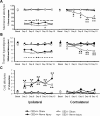

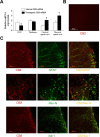
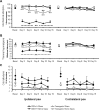
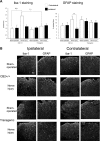
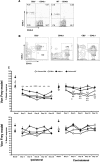
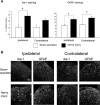
Similar articles
-
Interferon-gamma is a critical modulator of CB(2) cannabinoid receptor signaling during neuropathic pain.J Neurosci. 2008 Nov 12;28(46):12136-45. doi: 10.1523/JNEUROSCI.3402-08.2008. J Neurosci. 2008. PMID: 19005078 Free PMC article.
-
Direct evidence for spinal cord microglia in the development of a neuropathic pain-like state in mice.J Neurochem. 2006 Jun;97(5):1337-48. doi: 10.1111/j.1471-4159.2006.03808.x. Epub 2006 Apr 10. J Neurochem. 2006. PMID: 16606373
-
The cannabinoid CB₂ receptor-selective phytocannabinoid beta-caryophyllene exerts analgesic effects in mouse models of inflammatory and neuropathic pain.Eur Neuropsychopharmacol. 2014 Apr;24(4):608-20. doi: 10.1016/j.euroneuro.2013.10.008. Epub 2013 Oct 22. Eur Neuropsychopharmacol. 2014. PMID: 24210682
-
Activated microglia in the spinal cord underlies diabetic neuropathic pain.Eur J Pharmacol. 2014 Apr 5;728:59-66. doi: 10.1016/j.ejphar.2014.01.057. Epub 2014 Feb 6. Eur J Pharmacol. 2014. PMID: 24508519 Review.
-
[Pathophysiology of neuropathic pain: molecular mechanisms underlying central sensitization in the dorsal horn in neuropathic pain].Brain Nerve. 2012 Nov;64(11):1255-65. Brain Nerve. 2012. PMID: 23131736 Review. Japanese.
Cited by
-
Decreased cocaine motor sensitization and self-administration in mice overexpressing cannabinoid CB₂ receptors.Neuropsychopharmacology. 2012 Jun;37(7):1749-63. doi: 10.1038/npp.2012.22. Epub 2012 Mar 14. Neuropsychopharmacology. 2012. PMID: 22414816 Free PMC article.
-
R-flurbiprofen reduces neuropathic pain in rodents by restoring endogenous cannabinoids.PLoS One. 2010 May 13;5(5):e10628. doi: 10.1371/journal.pone.0010628. PLoS One. 2010. PMID: 20498712 Free PMC article.
-
Blockade of the Sigma-1 Receptor Relieves Cognitive and Emotional Impairments Associated to Chronic Osteoarthritis Pain.Front Pharmacol. 2019 May 3;10:468. doi: 10.3389/fphar.2019.00468. eCollection 2019. Front Pharmacol. 2019. PMID: 31130863 Free PMC article.
-
Interferon-gamma is a critical modulator of CB(2) cannabinoid receptor signaling during neuropathic pain.J Neurosci. 2008 Nov 12;28(46):12136-45. doi: 10.1523/JNEUROSCI.3402-08.2008. J Neurosci. 2008. PMID: 19005078 Free PMC article.
-
The Impact of CB2 Receptor Ligands on the MK-801-Induced Hyperactivity in Mice.Neurotox Res. 2017 Apr;31(3):410-420. doi: 10.1007/s12640-017-9702-4. Epub 2017 Jan 30. Neurotox Res. 2017. PMID: 28138895 Free PMC article.
References
-
- Agarwal N, Pacher P, Tegeder I, Amaya F, Constantin CE, Brenner GJ, Rubino T, Michalski CW, Marsicano G, Monory K, Mackie K, Marian C, Batkai S, Parolaro D, Fischer MJ, Reeh P, Kunos G, Kress M, Lutz B, Woolf CJ, et al. Cannabinoids mediate analgesia largely via peripheral type 1 cannabinoid receptors in nociceptors. Nat Neurosci. 2007;10:870–879. - PMC - PubMed
-
- Beltramo M, Bernardini N, Bertorelli R, Campanella M, Nicolussi E, Fredduzzi S, Reggiani A. CB2 receptor-mediated antihyperalgesia: possible direct involvement of neural mechanisms. Eur J Neurosci. 2006;23:1530–1538. - PubMed
-
- Bingham B, Jones PG, Uveges AJ, Kotnis S, Lu P, Smith VA, Sun SC, Resnick L, Chlenov M, He Y, Strassle BW, Cummons TA, Piesla MJ, Harrison JE, Whiteside GT, Kennedy JD. Species-specific in vitro pharmacological effects of the cannabinoid receptor 2 (CB2) selective ligand AM1241 and its resolved enantiomers. Br J Pharmacol. 2007;151:1061–1070. - PMC - PubMed
-
- Buckley NE, McCoy KL, Mezey E, Bonner T, Zimmer A, Felder CC, Glass M, Zimmer A. Immunomodulation by cannabinoids is absent in mice deficient for the cannabinoid CB(2) receptor. Eur J Pharmacol. 2000;396:141–149. - PubMed
-
- Carlisle SJ, Marciano-Cabral F, Staab A, Ludwick C, Cabral GA. Differential expression of the CB2 cannabinoid receptor by rodent macrophages and macrophage-like cells in relation to cell activation. Int Immunopharmacol. 2002;2:69–82. - PubMed
Publication types
MeSH terms
Substances
Grants and funding
LinkOut - more resources
Full Text Sources
Medical
Molecular Biology Databases
